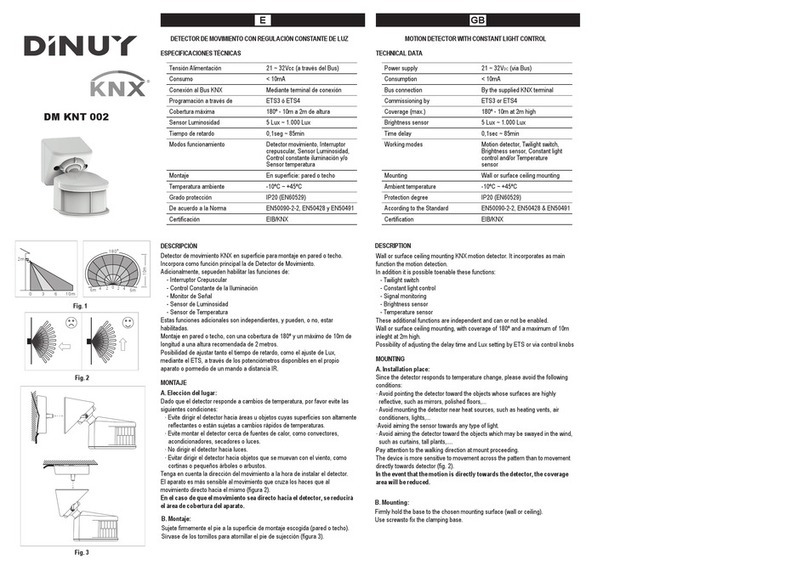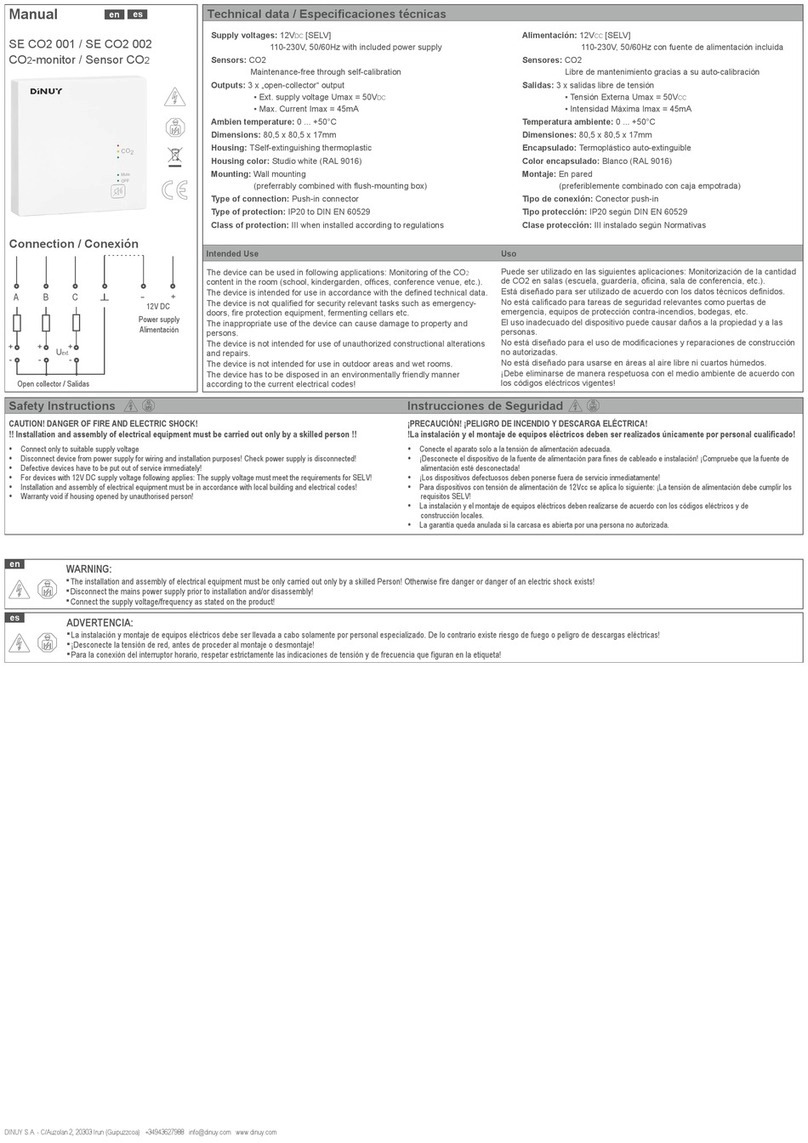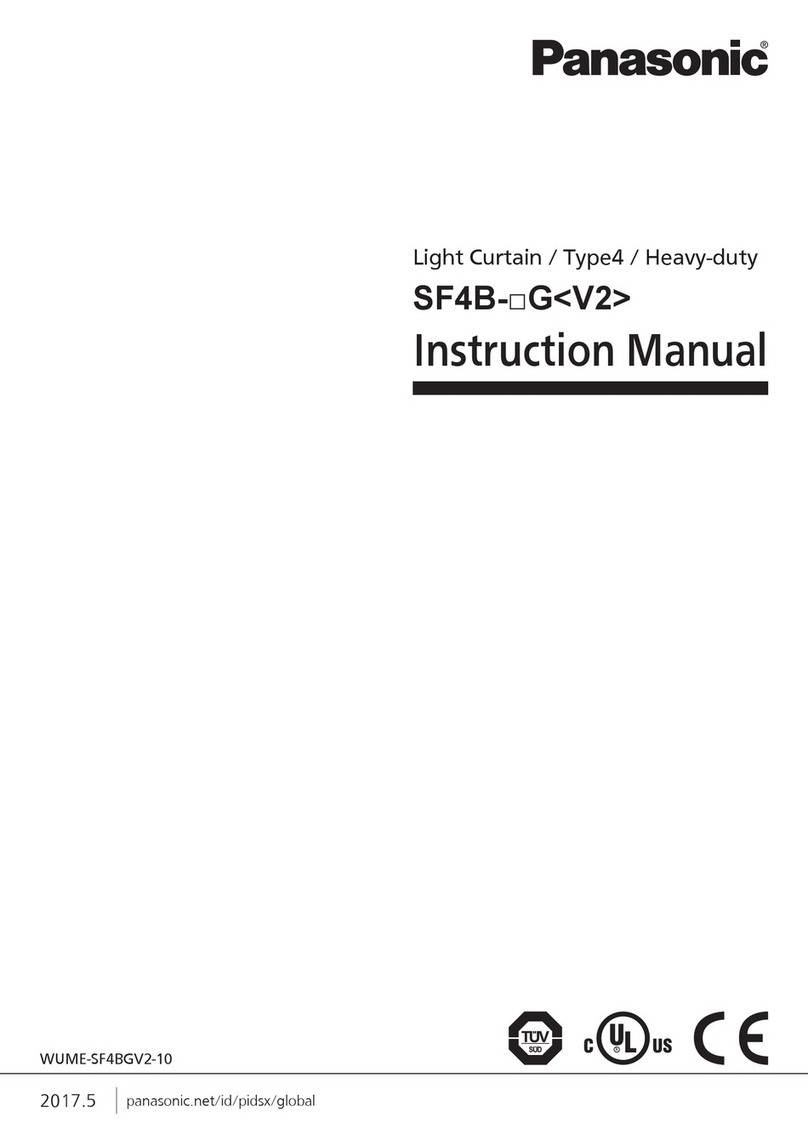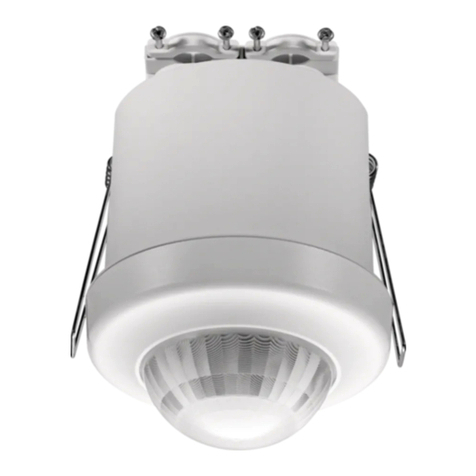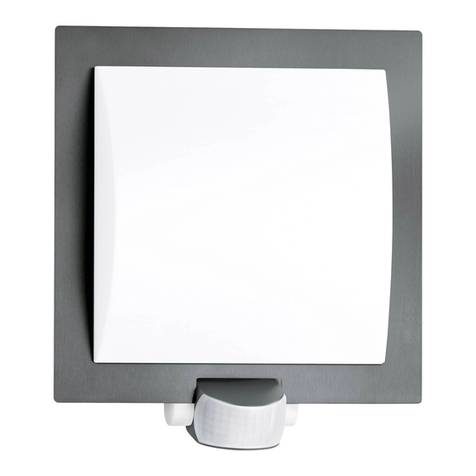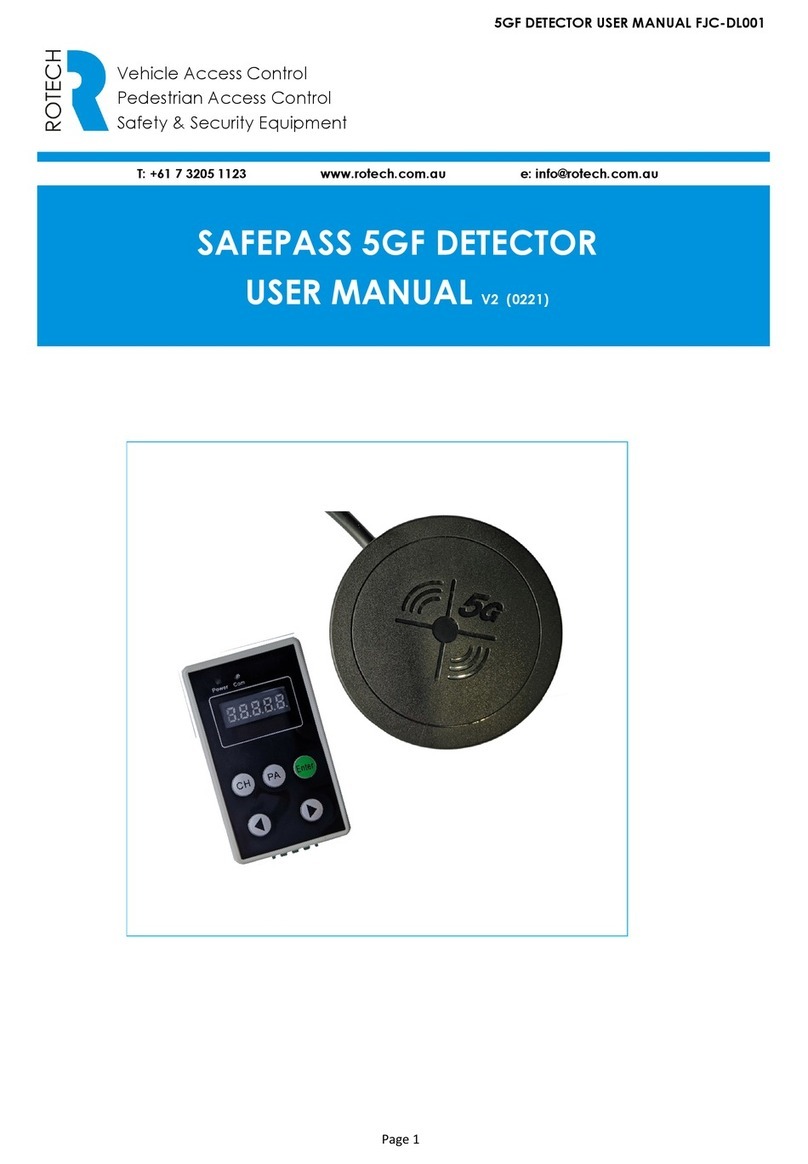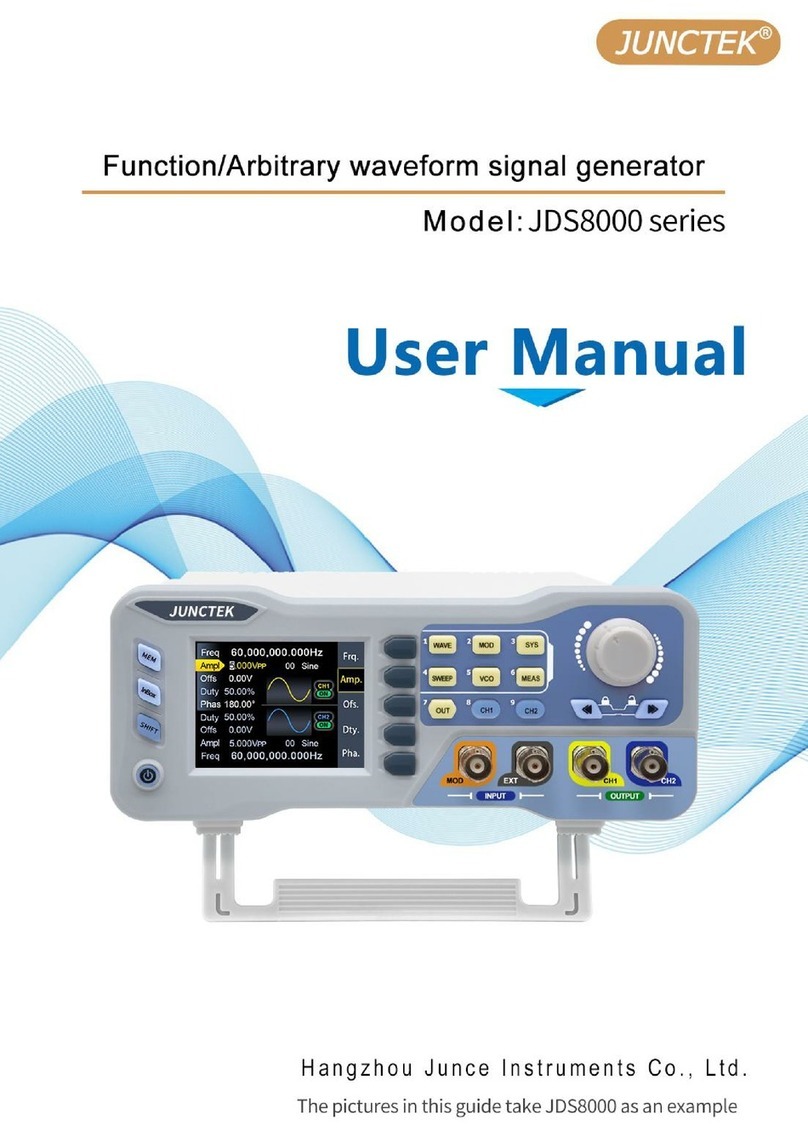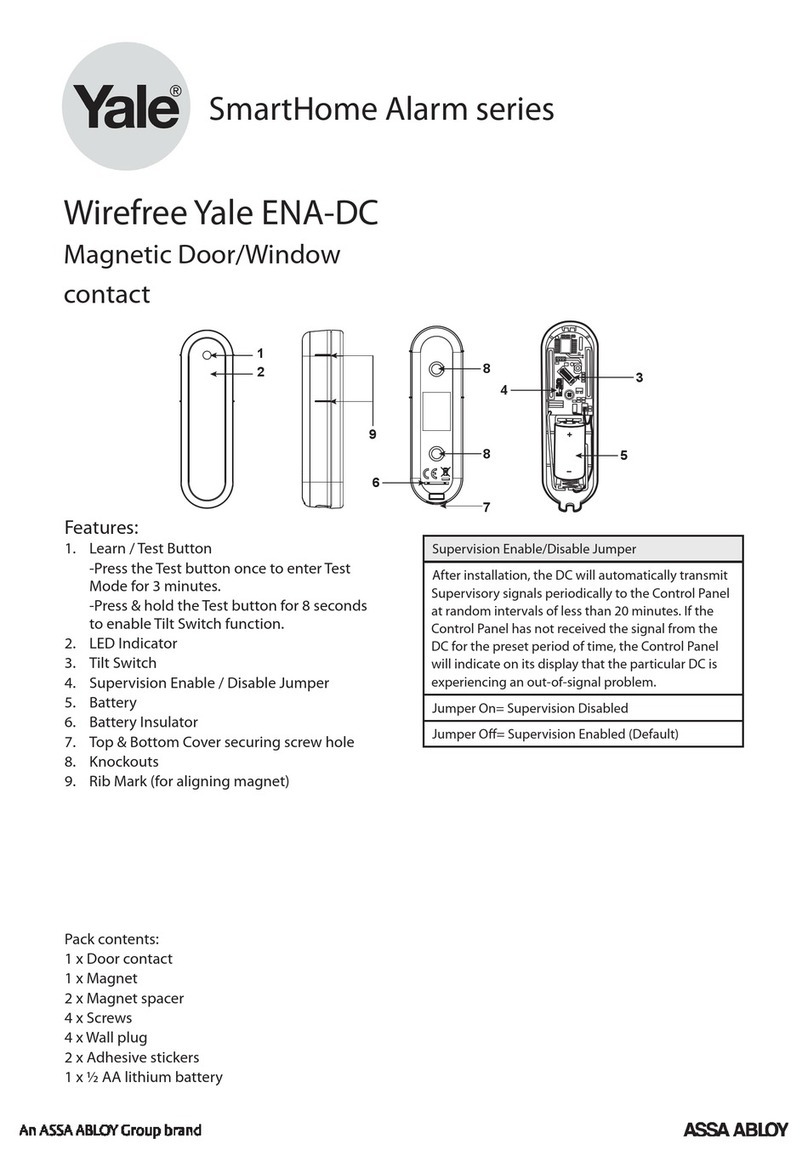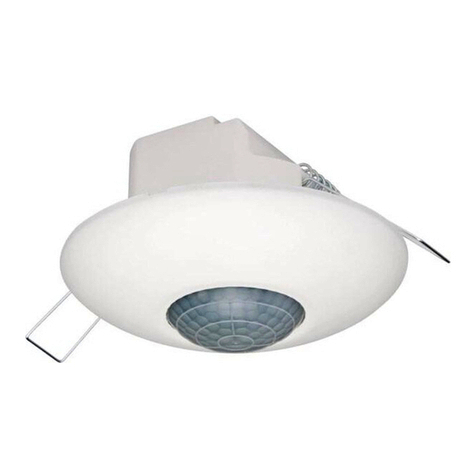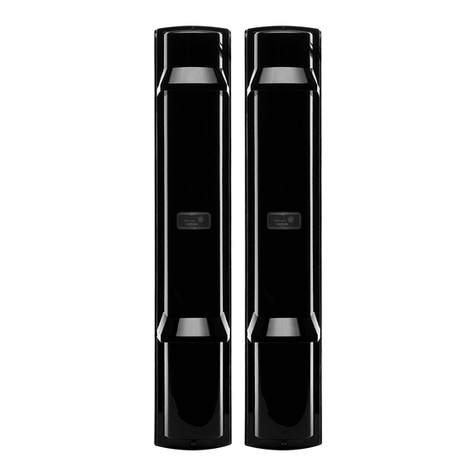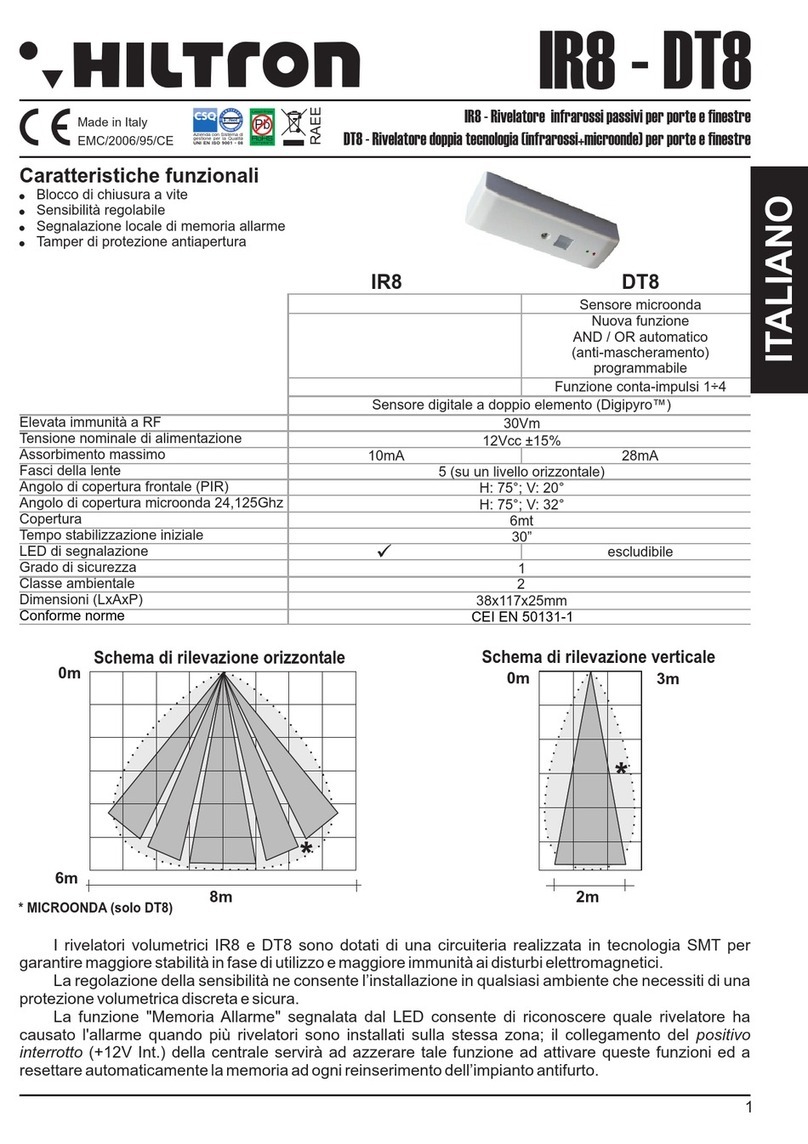DINUY DM KNX 002 User manual

EGB
DETECTOR DE MOVIMIENTO INALÁMBRICO
ESPECIFICACIONES TÉCNICAS
Tensión Alimentación 2 pilas de Litio AA (incluídas)
Duración Pila (estimada) >15 años (hasta 360 transmisiones
al día)
Radio-Frecuencia Emisión codificada en 868,4MHz
Compatible con KNX-RF
Protección Ambiental IP20
Tª Funcionamiento 0ºC ~ +45ºC
Cobertura 180º y 10m a 2m de altura
DESCRIPCIÓN
Sensor de movimiento que detecta pequeños cambios de temperatura, por
infrarrojos (PIR), dentro de su área de cobertura.
Dispone de sensor de luz, lo que permite limitar el funcionamiento en función de la
luz natural que haya.
Montaje en pared o en techo.
Incorpora LED, que se ilumina al detectar movimiento.
FUNCIONAMIENTO
En el momento que detecta movimiento, y el nivel de Lux está por debajo del nivel
de consigna ajustado en el detector, se envía una trama RF "TimeStartStop".
A partir de esta detección, el equipo entra en modo "stand-by" durante los
siguientes 30 segundos.
Desde el segundo número 30 al 55, el detector vuelve a habilitar la detección de
movimiento pero no habilita la emisión del telegrama correspondiente. Aún así, si
en este intervalo de tiempo se detecta algún movimiento, quedará memorizado en
el aparato.
A partir del segundo número 55, si hay detecciones memorizadas en el aparato o
se detecta algún movimiento, se vuelve a emitir la trama RF "TimeStartStop".
COBERTURA
Puede instalarse a una altura recomendada de 2 metros con el campo de
detección ampliable hasta unos 10m de longitud y una amplitud angular de 180º
(Fig. 1).
INSTALACIÓN
A. Elección del lugar:
Debido a que el detector responde a cambios de temperatura, por favor evite las
siguientes condiciones:
· Evite dirigir el detector hacia áreas u objetos cuyas superficies son altamente
reflectantes o están sujetas a cambios rápidos de temperaturas.
· Evite montar el detector cerca de fuentes de calor, como convectores,
aparatos de aire acondicionado, luces...
· Evite dirigir el detector hacia fuentes de luz.
· Evitar dirigir el detector hacia objetos que se muevan con el viento, como
cortinas o pequeños árboles o arbustos.
· Evite que el movimiento sea directo hacia el detector, ya que éste es menos
sensible que si el movimiento es transversal (Fig. 2).
B. Modo de instalación (Fig. 3):
Sujete firmemente el pie a la superficie de montaje escogida (pared o techo).
Sírvase de los tornillos para atornillar el pie de sujección.
DM KNX 002
WIRELESS MOTION DETECTOR
TECHNICAL DATA
Power supply 2 Lithium AA batteries (included)
Battery life (estimeed) > 15 years (up to 360 transmissions
per day)
Radio-Frequency Codified transmission in 868,4MHz
Compatible with KNX-RF
Protection degree IP20
Working temperature 0ºC ~ +45ºC
Coverage 180º & 10m at 2m high
DESCRIPTION
Motion sensor which detects small temperature changes (PIR) in its coverage area.
Built-in brightness sensor which permits to limit the detection to the daylight.
Wall or surface ceiling mounting.
Built-in LED which indicates motion has been detected.
OPERATION
As soon as it detects movement, and the daylight is under the Lux setting, it sends
"TimeStartStop" telegram.
From this detection, the device goes into "stand-by" mode during next 30 seconds.
From the second number 30 to 55, the detector re-enables the detection of
movement but does not enable the emission of the corresponding telegram.
However, if in this period of time motion is detected, it will be stored in the device.
From the second number 55, if there are detections stored on the device or
motion is detected, it reissues the RF telegram "TimeStartStop".
COVERAGE
It can be installed at a recommended height of 2 meters with the field
detection extendable up to about 10m in length and an angular amplitude of 180º
(Fig. 1).
INSTALLATION
A. Select a proper place:
Since the sensor responds to temperature changes, please avoid following
conditions:
· Avoid aiming the sensor towards areas or objects whose surfaces are highly
reflective or are subject to quick temperature changes, such as pools.
· Avoid mounting the sensor close heat sources, such as heatings vents, air
conditioning machines, dryers, vents or lights.
· Avoid aiming the sensor towards any type of light.
· Avoid aiming the sensor towards objects which may move by wind, such as
curtains, trees or bushes.
· Avoid direct movement toward the detector, since it is less sensitive than if the
motion is transversal (Fig. 2).
B. Installation procedure (Fig. 3):
Firmly hold the base to the chosen mounting surface (wall or ceiling).
Use screws to fix the clamping base.
Alcance Hasta 100m (en campo abierto)
Ajuste Luminosidad 1Lux ~ 100Lux
Sensibilidad Ajustable
Fig. 1
Fig. 2
Fig. 3
Range Up to 100m (in the free field)
Brightness setting 1Lux ~ 100Lux
Sensitivity Adjustable
0 3 6 10m
44 6m
6m 22 0
10m
2m
180
o

GB E
DINUY S.A.
c/Auzolan Nº2
20303 Irún (Spain)
info@dinuy.com
www.dinuy.com
AJUSTE Y PRUEBA DE FUNCIONAMIENTO
A. Conmutador ON / OFF
· ON - encendido
· OFF - apagado
B. Potenciómetro LUX. Ajuste Nivel de iluminación
Se puede ajustar un nivel de iluminación por encima del cual el detector de
movimiento no emitirá señal.
En caso de querer anular esta función de manera que el detector emita siempre
situar el potenciómetro LUX al máximo.
C. Potenciómetro MTR. Ajuste Sensibilidad
Aumenta y disminuye el campo de visión del detector.
A la hora de ser ajustado, es necesario comenzar desde "-" e ir aumentando poco
a poco hasta alcanzar la sensibilidad deseada.
A mayor sensibilidad de detección, mayor inestabilidad y por tanto, más
posibilidades de detecciones innecesarias.
D. Test de cobertura
1. Dirigir el detector hacia la zona que se quiere cubrir.
2. Encender el detector.
3. Esperar un mínimo de 30 segundos con el detector encendido.
4. Caminar desde fuera del área de cobertura hacia dentro hasta que se produzca
la detección.
5. Ajustar el detector cuanto sea necesario para cambiar la cobertura.
6. Repetir los pasos 4 y 5 hasta alcanzar la cobertura deseada.
CODIFICACIÓN ENTRE DETECTOR Y RECEPTOR
A. Enlace del detector con un receptor
Estos detectores pueden asociarse a diferentes tipos de receptores. La codificación
tiene dos partes, una asociada al propio detector y otra asociada al receptor,
explicada en las instrucciones de cada receptor.
Para que el receptor aprenda el código del detector de movimiento, hay que seguir
los siguientes pasos:
1.- Activar el modo programación en el receptor RF (según las instrucciones del
fabricante).
2.- Activar el modo programación en el detector RF, para lo cual situar el selector
ON/OFF en la posición ON.
3.- El detector envia una señal al receptor asociado.
4.- Desconectar el detector ya codificado situando el selector ON/OFF en la
posicion OFF para evitar interferencias si se quieren codificar más detectores.
5.- Una vez codificados todos los detectores con el receptor asociado, situar el
selector ON/OFF de todos ellos en la posición ON para su funcionamiento
normal.
IMPORTANTE: dejar una separación mayor de 2m entre el emisor y el
receptor a la hora de realizar el aprendizaje.
B. Borrado de un enlace
Para borrar un enlace entre un detector y un receptor RF, siga los siguientes pasos:
1.- Activar el modo borrado de un enlace en el receptor RF (según las
instrucciones del fabricante).
2.- Activar el modo programación en el detector RF, para lo cual situar el selector
ON/OFF en la posición ON.
3.- El detector envia una señal al receptor asociado.
4.- Desconectar el detector ya borrado situando el selector ON/OFF en la posicion
OFF.
BATERÍA BAJA
El detector indica que la batería está baja mediante un parpadeo constante de su
led rojo.
SETTINGS ANS TEST
A. ON / OFF
· ON - switch ON
· OFF - switch OFF
B. LUX knob. Brightness setting
It is possible to set the maximum light level at which the sensor will work.
In the case of wanting to cancel this function it will be possible setting the LUX knob
at maximum.
C. MTR knob. Sensitivity setting
Increases and decreases the coverage of detector.
At the time of being adjusted, it is necessary to start from "-" and increase it little
by little until the desired sensitivity.
A higher detection sensitivity, more unstable and therefore more possibility of
unnecessary detections.
D. Test procedure
1. Aim the sensor towards the area you want to cover.
2. Turn the power on.
3. Wait for 30 seconds until the detector becomes operative.
4. Start walking from outside the pattern inwards until the lights turn-on.
5. Adjust the detector as necessary to change coverage.
6. Repeat steps 4 and 5 until the desired coverage.
LINK PROCEDURE
A. Link process between the sensor and the actuator
This motion detector can be associated to different actuators.
The codification is composed by two steps, one in the detector and a second one
associated to the receiver, explained in its instruction manual.
In order to allow the receiver to learn the code from the sensor, these steps must be
followed:
1.- Set the RF actuator in link mode, according to the instructions given by the
manufacturer.
2.- Set the DM KNX 001 in link mode placing the switch at ON.
3.- The sensor sends a signal to the receiver.
4.- Switch off the codified detector placing the switch in OFF position to avoid
interferences if more detectors must be codified.
5.- Once all detectors are codified, please place the switch of all detectors in ON
position for the normal operation.
ATTENTION: leave a greater separation of 2m between the sender and the
receiver when performing learning.
B. Deleting process
In order to delete a link:
1.- Set the RF actuator in unlink mode, according to the instructions given by the
manufacturer.
2.- Set the DM KNX 001 in link mode placing the switch at ON.
3.- The sensor sends a signal to the receiver.
4.- Switch off the codified detector placing the switch in OFF position.
LOW BATTERY
The sensor indicates that the battery is low by a constant brief flickering of its red
LED.
MTR LUX
MTR LUX
Other DINUY Security Sensor manuals
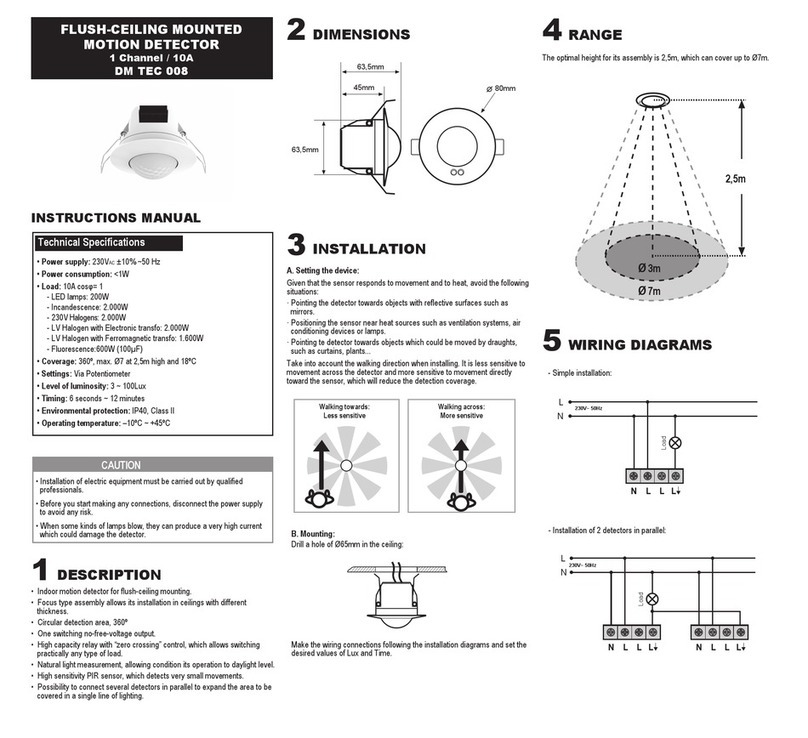
DINUY
DINUY DM TEC 008 User manual
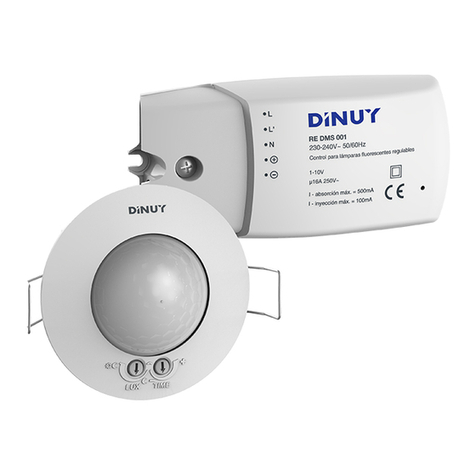
DINUY
DINUY RE DMS 001 User manual
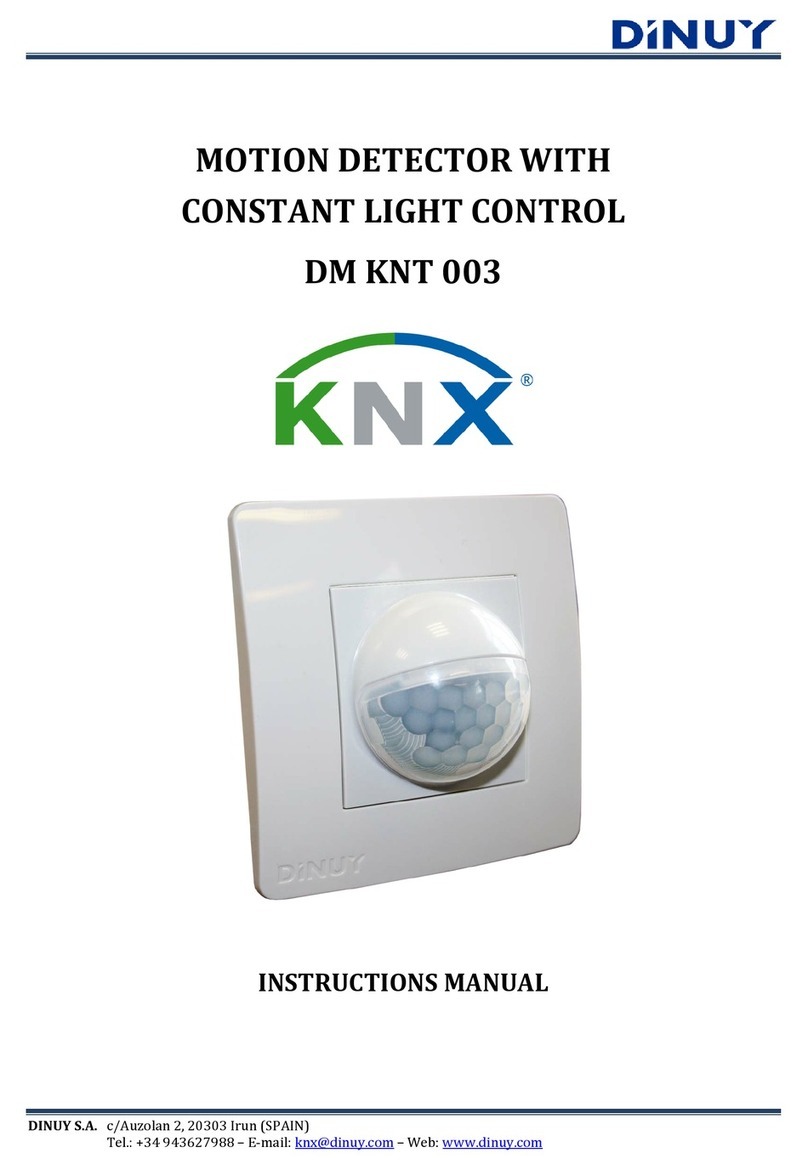
DINUY
DINUY KNX DM KNT 003 User manual
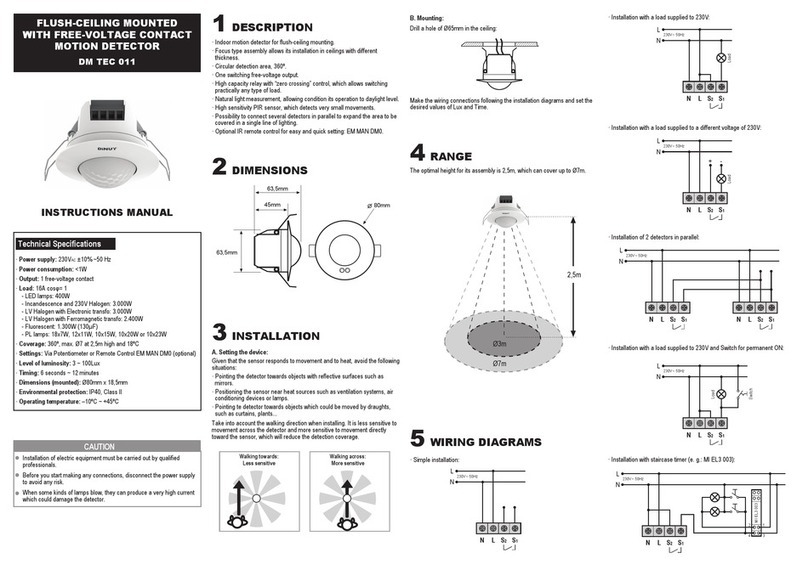
DINUY
DINUY DM TEC 011 User manual
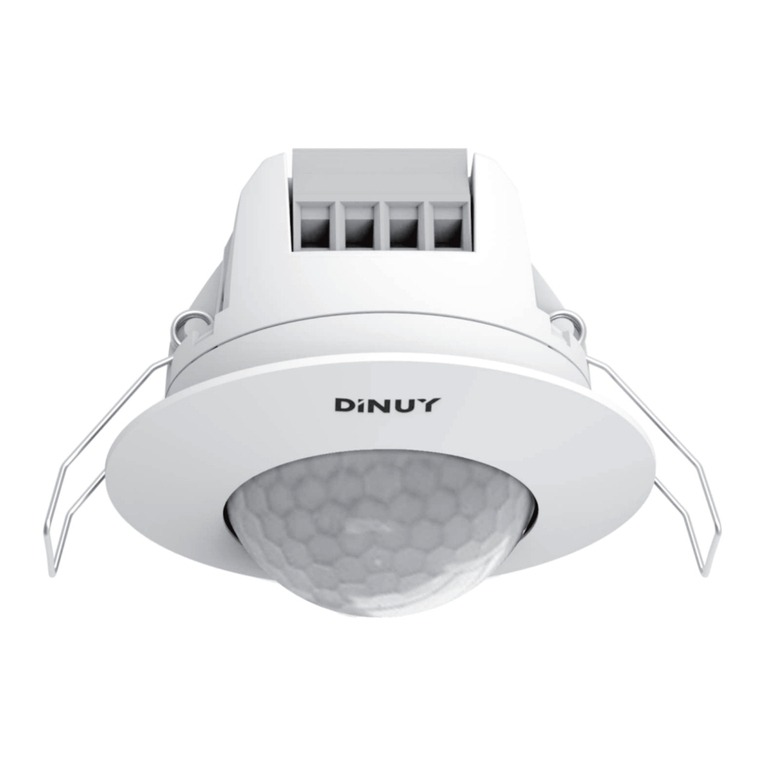
DINUY
DINUY DM TEC 243 User manual
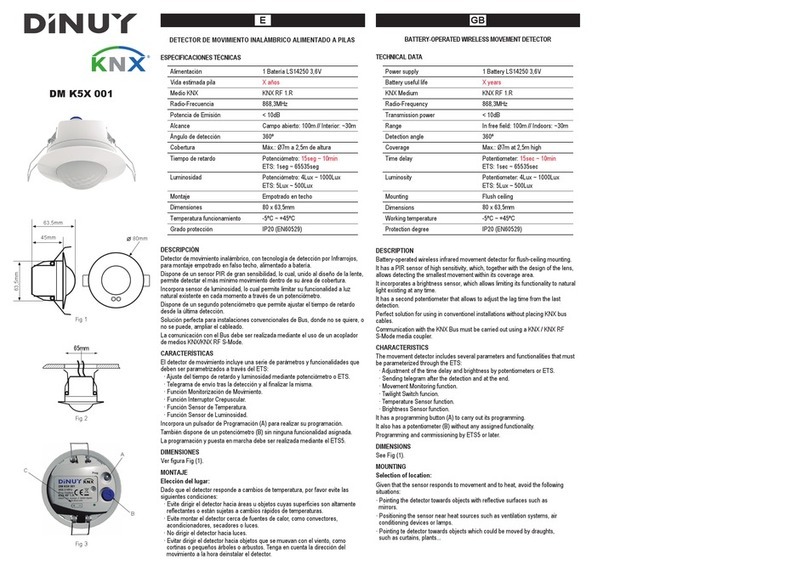
DINUY
DINUY DM K5X 001 User manual
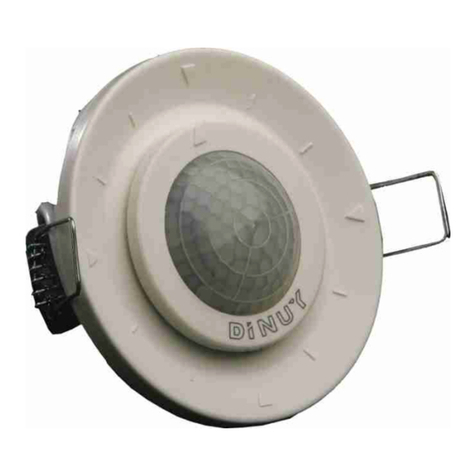
DINUY
DINUY DM KNX 001 User manual

DINUY
DINUY KNX DM KNT 003 User manual
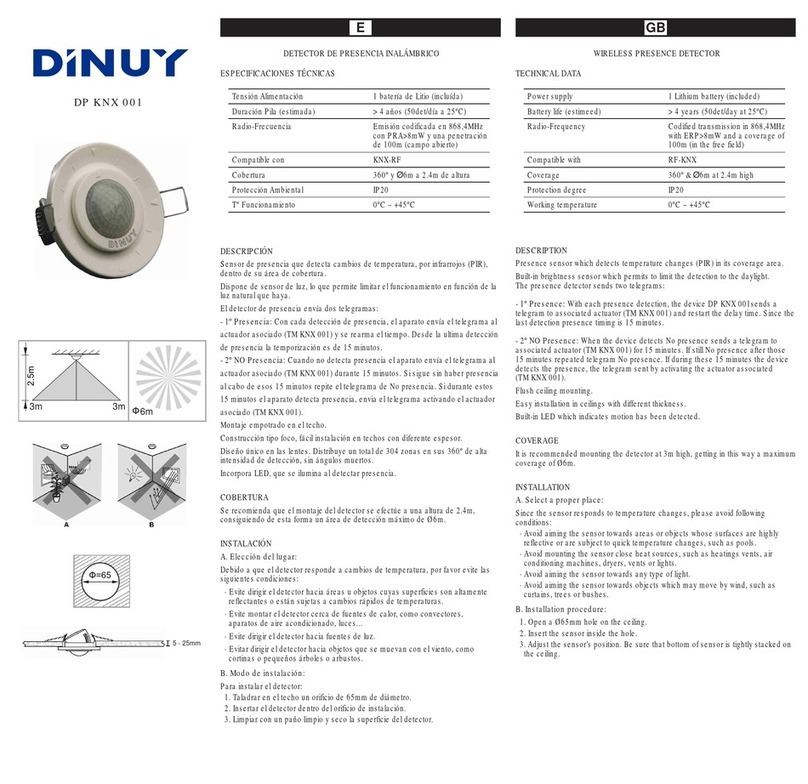
DINUY
DINUY DP KNX 001 User manual

DINUY
DINUY KNX DM KNT 003 User manual
Popular Security Sensor manuals by other brands
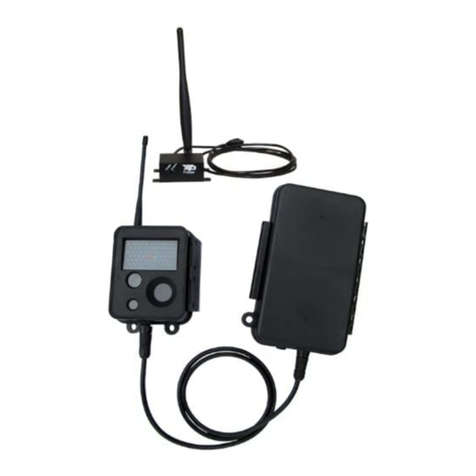
BuckEye Cam
BuckEye Cam X80 user manual

ITALIANA SENSORI
ITALIANA SENSORI 8057-ISR043 Installation, operation and maintenance manual
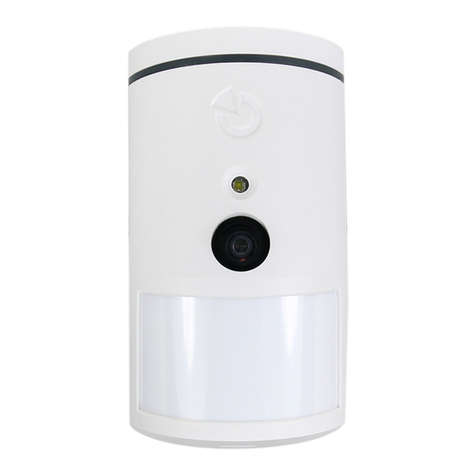
jablotron
jablotron JA-160PC manual
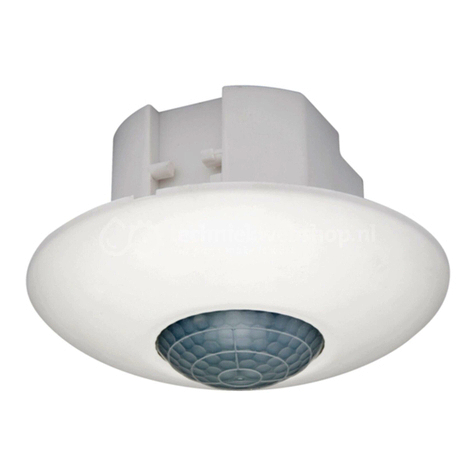
Niko
Niko 350-20056 user manual

rollease acmeda
rollease acmeda AUTOMATE ARC Motion Sensor instructions
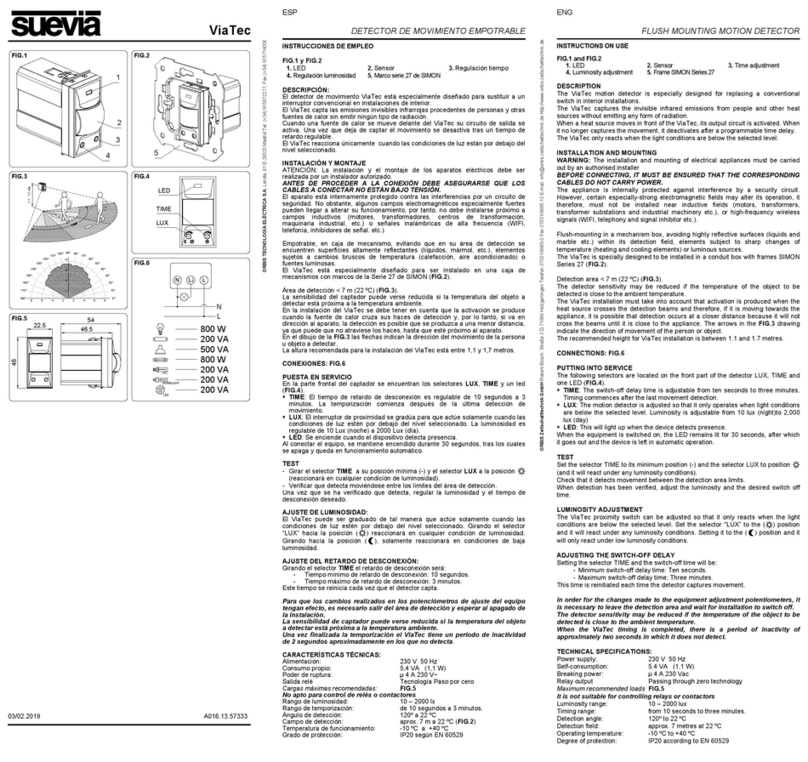
Suevia
Suevia ViaTec quick start guide

